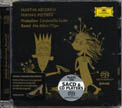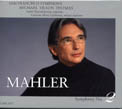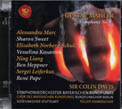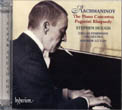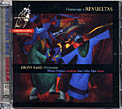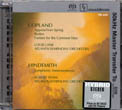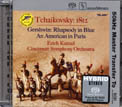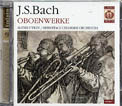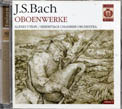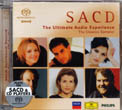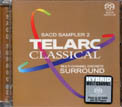|
You are reading the older HTML site
Positive Feedback ISSUE
16
Hi-Res reviews featuring our friends from Audiophile Audition Selections from the 45 SACD & DVD-A Reviews for this month - December 2004
PROKOFIEV: Cinderella Suite; RAVEL: Mother Goose Suite - Martha Argerich & Mikhail Pletnev, pianos - DGG multichannel SACD 00289 474 8682 - 49:47 5 Stars Have to admit I'm a patsy for multiple pianos, and when one can hear two of the greatest pianists on the concert stage today playing a work that has never been heard in a two-piano version before, and in hi-res surround sound on top of it, we have here an automatic disc of the month! Pletnev transcribed the delightful ballet of Prokofiev himself and dedicated the transcription to Argerich. He had earlier arranged the Nutcracker and some episodes from Rodion Shchedrin's Anna Karenina, so this wasn't entirely new for him. The art of the dance was entrusted to two pairs of hands, and the choreography and scenario of the original ballet took precedence over virtuoso outbursts for the two pianists. For those familiar with the orchestral score, it's sort of like putting the ballet under X-ray and seeing its structure more clearly. One section does have a bit of an outburst, but perfectly motivated: The pealing of the bell at midnight as Cinderella is rushing out of the ball. Pletnev holds down some of the strings while playing the keyboard with his free hand while Argerich hammers out dark mysterious chords on her piano. The effect, with the startlingly wide dynamic range, is mesmerizing. Ravel wrote his Five Pieces for Children for Piano 4 Hands originally, and later transcribed it for orchestra. It has less of the feeling of dance and more of impressionistic tone painting of the five scenes such as Tom Thumb and the Empress of the Pagodas. In Cinderella Argerich is heard on the left channel and Pletnev on the right; for Mother Goose Argerich sits on the left end of the bench, playing the bass section while Pletnev has the treble. When this combination of logistics appeared on standard CDs I could never exactly tell where the keyboards and/or performers were; with SACD there's no doubt. A highly recommended musical and audio demo disc! John Sunier Two more Mahler symphonies in multichannel—we seem to have at least one a month—they are made to order for music in surround!...
MAHLER: Symphony No. 2 - Isabel Bayrakdarian, soprano/Lorraine Hunt Lieberson, mezzo/San Francisco Symphony Chorus and Orchestra/Michael Tilson Thomas - multichannel SACD, San Francisco Symphony 821936-0006-2 (2 discs) - 88:00 5 Stars The latest in the magnificent SF Symphony Mahler series was recorded in June of this year and follows close on the heels of the exceptional encore recording of the work by Mahler 2nd specialist Gilbert Kaplan on DGG SACD. While that one bowled me over, I have to say MTT has the edge in this competition. His discing has more of a 3D quality of reproduction with a wonderful feeling for the acoustics of SF's Davies Hall. MTT has more variation in emphasis on different aspects of the work, and it's not just a matter of dynamic either. Kaplan almost seems to be saying in his interpretation "now listen to this... now. This... and THIS!" His almost sounds compressed sometimes because the more subtle passages are brought more forward. MTT ends up being more dramatic, and big climaxes just as strong as Kaplan's, but they seem to occur more naturally—with less effort expended. In the
second movement the various instrumental sections sound more delicate
and graceful than with the Kaplan, which has more multi micing of
individual instruments - bringing them closer in an unnatural fashion.
But the deep bass is stronger on the Kaplan discs. Both version are
terrific however, and you couldn't go very wrong with either one. The multichannel
version really shines in the "Urlicht" movement and the
lengthy finale, where the two female voices soar up and over the chorus
and orchestra in heavenly fashion. John Sunier
MAHLER: Symphony No. 8 in E Flat "Symphony of a Thousand" - 3 sopranos/2 altos/tenor/baritone/ bass/4 different choirs incl. a children's choir/Bavarian Radio Symphony Orchestra/Sir Colin Davis - RCA Red Seal multichannel SACD 82876 62834 (2 discs: 1:22:44; 2:60:30) 3 Stars This new release follows fairly recently after an excellent version in the other format - Riccardo Chailly's recording with the Royal Concertgebouw Orchestra on a Decca multichannel DVD-A. Besides employing different delivery methods, the two performances differ in that Chailly's—while recorded in the to-die-for acoustics of the Concertgebouw—had no audience present, while the Davis recording was assembled from two live performances given in Munich in l996. My feeling is that this difference contributes to the major contrasts between these two discs: Davis' version is more forceful, with the vocalists at times sound ing forced in their delivery, and the higher reaches of the sopranos suffering from some IM distortion. The
DVD-A version is more laid-back, lyrical and with less distortion in the
peaks and major climaxes. All of the soloists are equally excellent but
in the DVD-A they sound less strained and so does the orchestra.
Chailly's 8th also preserves a better feeling of the interior of the
Concertgebouw and in the end is more powerful due to less forcing and
rushing. Much has been written about this most epic of Mahler's
symphonies which combines a huge assembly of vocal and instrumental
forces in first an imposing piece of liturgical music in Latin and then
suddenly a highly stylized choral-orchestral staging of the final scene
from Goethe's Faust. Somehow it all works if all the elements come
together properly, and Chailly ensures they do. The final few minutes of
the Finale are distinguished by tremendously deep bass—what an audio
demo! Guess I'm reviewing the competition more than the disc at hand, so
that indicates my preference. John Sunier
RACHMANINOFF: The Four Piano Concertos = No. 1 in F sharp minor; No. 2 in C minor; No. 3 in D minor; No. 4 in G minor; Rhapsody on a Theme of Paganini - Stephen Hough, piano/Dallas Symphony Orchestra/Andrew Litton - Hyperion multichannel SACD SACDA67501/02 (2 discs) - 145:35, 4 Stars All four of the concertos were recorded live in concerts at the Morton Meyerson Symphony Center in Dallas. Only the Paganini Rhapsody was recorded earlier without an audience but in the same hall, as a sort of rehearsal for the four-concerto epic performances and recording sessions. Hough has known Rachmaninoff's recordings of his four concertos on RCA Victor for most of his life and wanted to draw closer to those more Romantic treatments replete with rubatos, pauses for effect and other tricks which most pianists of today strive to avoid. He learned fluency in the pianistic language of that time - which was not only Rachmaninoff's. And this applied not just to the piano but also to the style of orchestral playing. Hough wanted a conductor who felt the same way about the works and succeeded on that count with Andrew Litton. His concertmaster understood and appreciated the Romantic style with some gentle slides in the string section. There were four performances of each of the concertos, and Hough reported that one would think that is more than enough to get things right on the final live performance edit. But he indicates that doesn't seem like much when you add in cell phones, coughs, noisy page-turns, inevitable wrong notes and ensemble problems, beepers, a thunderstorm with lightning, and a snoring audience member! While I find the Mercury 3-channel reissue of 2 & 3 more exciting both performance-wise and sonically, all four of these concertos are beautifully recorded in a more distant perspective in the Hyperion set, and for once the piano seems to be its actual size. With the added realism of the surround channels' impression of the hall, and the more Rachmaninoffian style this becomes a very interesting close-listening experience with the music. John Sunier
LISZT: Dante Symphony; Tasso - Lament & Triumph - London Symphony Orchestra/Leon Botstein (with London Oratory School Schola Choir in Dante Sym.) - Telarc multichannel SACD-60613 - 63:54, 4 Stars Liszt avoided the standard symphony but he did create two of his symphonic poems that were very close—his Faust Symphony and this one on Dante's Divine Comedy. The 42-minute work has two movements: Inferno and Purgatorio. The choir is heard in a few lines from Dante's work near the end of each of the two movements. Interesting that we never quite make it to heaven—only to Purgatory. Tasso was the author of a popular book of the Renaissance, on the First Crusade. The Tasso music was originally an overture for a stage production on the life of the poet. The sad tone of the first section gives way, using the same melodies, to the rich and radiant sounds of the concluding triumph. It strikes me that both these Liszt works would be interesting listening when paired with Mahler's Eighth. Sound is very rich and enveloping, with good deep bass support and a wide orchestral layout. John Sunier
Homenaje a REVUELTAS = Chamber Works of SILVESTRE REVUELTAS - Sensemaya, Ocho por radio, Planos, Caminando, Este era un rey, Hora de Junio, El renacuajo paseador, Pieza para doce instrumentos; Homage to Frederico Garcia Lorca - Ebony Band, Amsterday/Werner Herbers - Channel Classics multichannel SACD CCS SA 21104 - 66:21, 4 Stars Revueltas, best known for his sinewy little tone-poem Sensemaya, was one of the most original and creative of Mexican composers, mixing modern classical idioms with Mexican folk themes. 1999 was the celebration of the 100th birthday of the composer and RCA Victor issued a 2-CD Centennial Anthology of 15 of his works, both chamber and full orchestra, featuring The London Sinfonietta, New Philharmonia, and even Leopold Stokowski. A special concert of Revueltas' chamber works was given that same year in Amersterdam by an ensemble which has celebrated his music ever since their founding. The Ebony Band has campaigned for the composer who they feel is unjustly neglected today. Last year they gave another live Revueltas concert and that one was recorded by Channel Classics in DSD. The concert features a newly-discovered final version of the composer's Homage to Lorca and lively versions of such enjoyable pieces as Eight for Radio—an evocation of the mariachi bands which might be heard tuning the radio dial in Mexico—and the hypnotic ritual dance Sensemaya—here in a chamber version for 15 players which doesn't make as much noise as the orchestral treatment but has plenty of rhythmic excitement going for it. Hora de Junio is instrumental backing for the reading of three poems by Carlos Pellicer, who like Revueltas, has been in Spain in support of the resistance movement. To the point, sometimes humorous and sometimes heartwarming—that's Revueltas' sound. The 5.0 surround sound is clean and ungimmicky, as is Channel Classic's practice. John Sunier
COPLAND: Appalachian Spring Suite; Rodeo; Fanfare for the Common Man - Atlanta Symphony Orch./Louis Lane; HINDEMITH: Sym. Metamorphosis - Atlanta Symphony Orch./Robert Shaw - Telarc stereo SACD from Soundstream masters SACD-60648 - 64:38 4 Stars Another in the series of earlier Soundstream digital masters taped by Telarc using the non-standard 50K digital system. When originally decimated down to 44.1K there were problems in accurately modeling the higher res signal. The complex math required involved the loss of some resolution along with the rolling off of frequency response. But now that DSD has a range of over 100K that conversion is much simpler and we can hear for the first time on a SACD the wider frequency response and increased resolution of the original Soundstream recordings. The readings of the Copland selections are suitably energetic and the much-played Appalachian Spring boasts rich and succulent string tone throughout. But it is the colorful Hindemith work that caught my ear - perhaps the most colorful of all the composer's works and not in the least suffering from the dry academic quality often decried in this composer. There is also an outstanding mono recording of this work on a Telarc CD, but this SACD stereo version surpasses it as a satisfying aural experience. If you want a bit of surround feel with these stereo mixes, just fire up your Dolby Pro Logic II—the higher-res source decodes successfully to surround. John Sunier
TCHAIKOVSKY: 1812 Overture; Capriccio Italien; Cossack Dance from Mazeppa; GERSHWIN: Rhapsody in Blue; An American in Paris - Cincinnati Symphony Orch./Erich Kunzel - Telarc stereo SACD from Soundstream masters SACD-60646 - 69:19, 4 Stars An interesting set of disc mates to be sure. This was the first digital recording of the 1812 complete with cannons, and I think it is quite a bit better performance than the recent one which was issued on both DVD-A and SACD simultaneously. Again, the 50K Soundstream tapes can be more successfully converted to over 100K DSD/SACD than was possible with 44.1 CDs. Eugene List is the soloist in the Rhapsody in Blue and it has never sounded as good as this in the CD version. American in Paris is a rollicking tour de force which may not beat out Bernstein's white hot version on Columbia (Sony Music), but it is certainly better sound. John Sunier
J. S. BACH: Oboe Works, Vol. 1 - Hermitage Chamber Orchestra / Alexei Utkin, Director - Caro Mitis CM 0012003 - Multichannel Hybrid SACD - 63:00, 5 Stars Three of the works presented here are reconstructions that are based on a good deal of scholarly skullduggery over the latter part of the twentieth century. According to the author of the liner notes, Bach's keyboard concertos are "re-compositions," almost certainly based on earlier works for oboe, violin and strings, the scores of which have since been painstakingly reconstructed as presented here. The fourth work is a transcription by leader Alexei Utkin for oboe, flute and violin, and is rooted in the same research efforts. Regardless of how we arrived at this point, these recordings as presented on this disc from Russian label Caro Mitis represent the best of the best; while anyone familiar with Bach's keyboard concertos will immediately recognize their origins in these works, they possess a freshness and immediacy that are an absolute joy to listen to! A quick read through the supplied technical information reveals that all the microphone amplification was custom built by Polyhymnia, with the DSD conversion by Meitner and Pyramix, and the proof is in the listening. These recordings just sparkle with life—they're among the most realistic, natural sounding SACDs I currently own. This is a superb effort from Caro Mitis, and as pleasantly surprised as I was with the elegant packaging and beautiful label art, the real treat came with listening to these excellent discs. I could keep piling on the superlatives, but I think you get the picture—these discs are a must-have, and very highly recommended! Tom Gibbs
BACH: Oboe Works (Vol. 2) - Orchestral Suite No. 1 in C Major; Sonata in G minor for Oboe and Harpsichord; Concerto in D minor for Oboe and Violin (Transcription of Concerto for 2 Violins & Orch.); Italian Concerto in F Major for Harpsichord - Alexei Utkin, oboe/Hermitage Chamber Orchestra - Caro Mitis multichannel SACD CN 0032003 - 69:09, 4 Stars Another superb SACD from this new Russian classical label. Production is courtesy of the Dutch company Polyhymnia International B.V., using custom built, Pyramix and Meitner/EMM Labs gear. Recordings are made at studios of the Russian TV and Radio Broadcasting Company in Moscow using Schoeps, B & K and Neumann microphones. The performers may be unknown but have sounded superbly skilled on the discs I have so far heard. This ensemble, Heritage, numbers 15 young Russian players who are all graduates of the Tchaikovsky Conservatory in Moscow, and the leader of the group is oboist Utkin. The theme of this disc is Three Images of the Baroque Trio, and the booklet notes are well-translated from the Russian and good reading. The Italian Concerto provides the encore to the program. It's interesting to hear the well-known Orchestral Suite played by such a chamber group. And the Two-Violin Concerto is just as gorgeous and transporting a work in this chamber version as with a full symphony. All the soloists are first rate and the surround recording is a model of realistic reproduction—without either overdoing the surround channels or keeping them at such a low level they are next to useless. John Sunier
A little stack of SACD samplers has been building up for some months near my components, and this seems a good time to cover them. It strikes me they would make great gifts for audiophiles on your list who you know have a SACD player, because they would serve as an aural introduction to other complete releases on the same label they might want to add to their collection, and you don't need to know anything about their musical tastes or present collection. They are also great test discs when compared and purchasing almost any sort of digital audio gear. All are hybrid and multichannel, so you can also use the excellent CD layers to test players if you would also like your new SACD player to function as your best CD playback unit.
THE CLASSICAL SAMPLER - Decca/DGG/Philips multichannel SACD 474 964-2 - 70:21, 3 Stars MAHLER: Sym. No. 3 excerpt - Boulez; DVORAK: Slavonic Dance Np. 72/1 - Fischer; Song to the Moon - Netrebko; BEETHOVEN: Romance for Violin - Mutter; GASPARINI: Il nocchier - Andreas Scholl; PUCCINI: O soave fanciulla - Gheroghiu, Alagna; BELLINI: Ah Non credea mirati, Fleming; BIBER: Kyrie - McCreesh; MUSSORGSKY: Sel. from Pictures at an Ex. - Gergiev; MAHLER: Sym. No. 2 excerpt - Kaplan; CHOPIN: Waltz Op. 64/3 - Ashkenazy; DONIZETTI: Com' é gentil - Florez; WAGNER: Wie Todesahnung - Terfel/Abbado; MESSIAEN: Sel. fr. Turangalila-Symphonie - Chailly Several of these are complete selections or movements without fadeouts, which is nice. The variety of sources—including piano, full symphony, solo and choral voices—makes for a good series of component tests but since most of these were mastered from PCM sources and often as low as 44.1K sampling rates, rather than direct to DSD, the fidelity is not quite demo quality although better than most CDs.
SUPER ARTISTS ON SUPER AUDIO - Channel Classics multichannel SACD CCS SA SEL 3404 - 70:00, 4 Stars Sel. from BACH: Christmas Oratorio - Netherlands Bach Society; Allegro from SHOSTAKOVICH: Cello Sonata in D Minor - Wispelwey/Lazic; TUNDER: Song from Death & devotion - Johannette Zomer; HAYDN: Allegro fr. Sonata in E-flat major - Lazic, piano; TCHAIKOVSKY: Souvenir de Florence: Adagio - Amsterdam Sinfonietta; Follow That Star - The Gents; BACH: Contrapunctus 7 fr. The Art of Fugue - New Century Saxophone Quartet; HAYDN: Andante fr. "Clock" Sym. - Florilegium; ROSSINI: sel. from Quelques riens pour album - Giacometti, piano; Sel. fr. Splendore di Roma - soprano & theorbo; BACH: Fugue Around the Clock - Amsterdam Loeki Stardust Quartet (recorders); PIAZZOLLA: Homage to Lieja - Katona Twins, guitars; RACHMANINOFF: Sym. No. 2 in E minor: Adagio excerpt - Budapest Fest. Orch./Fischer Channel Classics, one of the pioneers in SACD and classical, records everything direct to DSD, and I believe only the final track here is faded out—the rest being complete selections or movements.
CLASSICAL SACD SAMPLER II - Telarc multichannel SACD-60007 - 67:11, 4 Stars PURCELL: Rondeau from Abdelazer - Empire Brass Quintet; PROKOFIEV: Death of Tybalt from Romeo & Juliet - Cincinnati Sym./Järvi; THEOFANIDIS: Rainbow Body - Atlanta Sym./Spano; LECUONA: Malaguena - Kondonassis, harp; Sel. from Canticum Canticorum - Tapestry; HOVHANESS: Double fugue from Mysterious Mountain - Royal Liverpool/Schwarz; BEETHOVEN: Presto excerpt from Sym. No. 9 - Atlanta/Runnicles; ROSZA: Parade of the Charioteers from Ben Hur - Kunzel; String of Pearls - Kunzel; GRIEG: Sel. fr. Holberg Suite - Rotterdam Ch. Orch.; HANDEL: La Rejouissance fr. Music for the Royal Fireworks - Boston Baroque/Pearlman; MAHLER: excerpt fr. Sym. No. 6 - Philharmonia/Zander; STRAVINSKY: Infernal Dance from The Firebird - Cincinnati/Järvi; End Theme from Sleepy Hollow - Kunzel; 4 Reels - Ensemble Gallilei Telarc has a long history as a leading audiophile label and has been making all their SACD masters using DSD. Several of the selections here are complete works, including the 13-minute-long Rainbow Body, which is an amazing demonstration of varied orchestral colors and sounds.
SACD SAMPLER 3: JAZZ - Telarc multichannel SACD-63008 - 70:54, 4 Stars Zona desperata - Al Di Meola; Django - Monte Alexander; Oh Mr. Sauter? Yes, Mr. Finegan - Gerry Mulligan; Papa Was a Rolling Stone - John Clayton; Along Together - Tierney Sutton; If I Were a Bell - McCoy Tyner; Tequila - Michel Camilo, p. ; I Like Jersey Best - John Pizzarelli Trio; Air on a G String - Jacques Loussier Trio; Another Mind - Hiromi, p.; Battle Hymn of the Republic - Monty Alexander This is a great collection just for background listening as well as demo purposes. The opening track is over nine minutes and several others are about eight. There's a strong focus on piano which sits my personal tastes perfectly.
CONCORD JAZZ SUPER AUDIO CD SAMPLER VOLUME 2 - Multichannel SACD-1035-6, 4 Stars Monte Alexander's Ivery & Steel: Reggae Later; Nnenna Freelon: Nature Boy; Ray Brown Trio: The Real Blues; Herb Ellis & Joe Pass: 7 Come 11; Scott Hamilton: Goodbye Mr. Evans; Susannah McCorkle: The Waters of March; Pete Escovedo: Whatcha Gonna Do; Maynard Ferguson & Big Bop Nouveau: It Don't Mean a Thing; Jack McDuff/Joey DeFrancesco: Funk Pie; Karrin Allyson: No Moon at All; Gary Burton: Elucidation; Marian McPartland: Silent Pool. While they don't record direct to DSD, Concord has been recording multitrack for decades, and so has a huge library to pull source materials from to remix for 5.1 surround. And so they do, and very convincingly too—you'll hear more than just very low level reverberation out of those surround speakers; in fact sometimes they really get a workout! None of the dozen tracks fade out, and some are well over seven minutes in length. Three vocal tracks are peppered into the instrumentals, and one of them—"The Waters of March"—gets my vote for the most gorgeous bossa nova tune ever written. John Sunier Reviews reprinted with permission from Audiophile Audition
|


